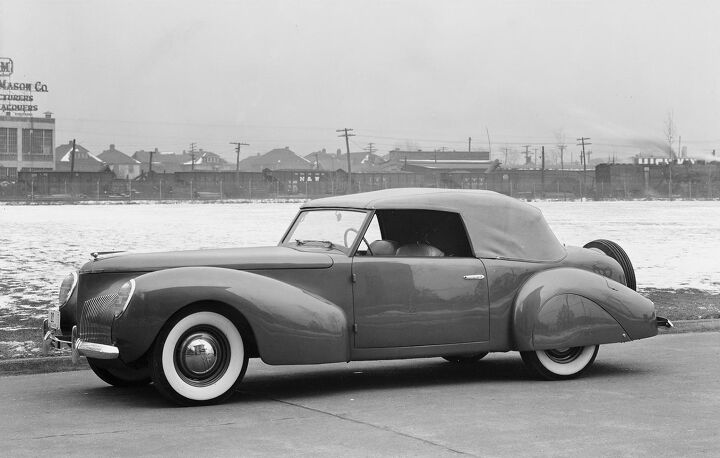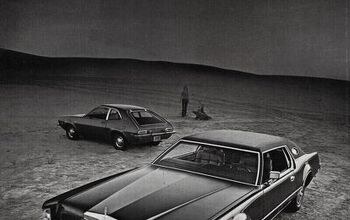Rare Rides Icons: The Lincoln Mark Series Cars, Feeling Continental (Part I)

Rare Rides Icons concluded its 22-part series on the Imperial recently, as the long-running luxury model-brand-model exercise by Chrysler came to its timely end in 1993. Today we embark on a new luxury car series. It’s one you’ve asked for, and it’s also about luxury cars and will be an extensive series. Come along, as we consider the life and times of Lincoln’s Mark series cars.
To get to the first Mark series car and indeed the launch of the Continental as a brand, we travel first to the late Thirties. Lincoln’s lineup consisted of two lines of vehicles, both of them large. Of standard full-size car designation was the quite modern Lincoln-Zephyr line, which went into production for 1936. The Zephyrs were a competitor to the likes of the new Chrysler Airflow and regular-sized Packards.
The other car Lincoln sold was the K-Series. In production since 1931, the aged K was much more luxurious than the Zephyr. V12 engines, various wheelbase lengths, and coachbuilt bodies were all a part of K. It competed with 12-cylinder Cadillacs, the Pierce-Arrow Model 63, and V12 Packards. The K-Series was headed to the end of its life at the end of the Thirties and was canceled in 1939. Its replacement in 1941, the Custom, was offered only in limo and sedan format and was not offered as a chassis to coachbuilders like the K was prior.
These full-size and formal limousines were unsuitable for one specific idea that company president Edsel Ford had: A more personal luxury car in the European tradition, suitable for vacation-type driving. Ford took a vacation to Europe with his wife in 1938. While there, he was most pleased with the elegance and sophistication of European luxury automobiles and brought some new ideas when he flew back home to Detroit.
In 1938 neither a Continental-style American car nor a domestic personal luxury car existed. Edsel met with Lincoln’s lead designer Eugene T. Gregorie after the vacation. A challenge was issued to create an all-new type of Lincoln in the European image. Gregorie pulled out some sketches of the current Lincoln-Zephyr (the only standard production car Lincoln offered).
From that basis, Gregorie worked up a personal version of the Zephyr with a convertible body. It was more modern than the Zephyr and featured more European-type styling influences. Edsel liked the idea and wanted the prototype finished for his vacation in March 1939. It’s reported that Gregorie finished the design sketch in about an hour, and then the staff at Lincoln set to work. The project was known as the Lincoln-Zephyr Continental.
The prototype was much lower to the ground than the Zephyr, a full seven inches. It removed the expected running boards for a streamlined look and had its hood almost level with the fenders. The unusual looks were highlighted in their paintwork, not chrome: The shiny material was minimized and used mostly around the grille.
This new coupe set a couple of styling precedents that American cars followed for some time. The lower hood line and ride height was a new look, compared to most luxury vehicles of the time with their towering hoods and grilles. Additionally, the passenger compartment was closer to the rear of the car than coupes up to that point, which gave the long hood, short rear deck look which is today considered compensatory in an automobile. There was a full foot of sheet metal added to the hood of the Continental over the standard Zephyr.
Because of the short rear deck, there was not a lot of room for the spare tire in the trunk. Gregorie wanted to find a place to store it in there, but Edsel insisted it go on the outside like a European car. Thus it was covered and mounted on the rear of the car. We’d later call that the Continental kit.
The completed prototype was delivered to Edsel Ford in Florida, in time for its requested vacation usage. While down there, the wealthy who buzzed in the same circles as Edsel found the Continental quite striking. Edsel sent a telegram and promised Ford HQ that he could sell a thousand Zephyr Continentals, and already had orders for 200. The Continental name stuck given the convertible’s European design influence.
All first-generation Continentals used the same 292 cubic-inch (4.8-liter) V12 engine as the Lincoln-Zephyr line. The V12 was specific to the Zephyr and was produced from 1936 with the Zephyr’s introduction. Its creation was forced, as the L-head V12 engines Ford already produced wouldn’t fit into the streamlined, slimmer shape of the new Zephyr. The engine’s design started with Ford’s newest Flathead V8 as its basis and was then enlarged.
The V12’s design ended up considered more a 12-cylinder Ford engine by those in the know than a purpose-specific Lincoln V12. With aluminum alloy heads, two water pumps, and steel pistons, the engine was not a simple one. It used a distributor that was unique to the engine and had two coil assemblies – one for each bank of cylinders. The engine offered 110 horsepower, which was more than Ford planned to get out of it during development.
Zephyr’s engine was quickly infamous for its sludge, poor oil flow, and overheating issues. Teething problems were mostly resolved by Ford engineers after the first model year, but the V12 had its reputation set by that time. It was further massaged in 1938 prior to its Continental usage when Ford added hydraulic lifters and implemented cast iron heads in place of the original alloy ones.
Worth an aside, the Zephyr V12 was appealing to low-volume British luxury manufacturers, who found engine reliability to be a lesser concern. Allard (1934-1939; 1945-1949) used them in their modified Ford vehicles, while the short-lived Atalanta (1937-1939) used the V12 in both their models made in Middlesex. Finally, Brough Superior (1919-1940) used the engine in the cars they produced, though the company was better known for its motorcycles and sidecars.
Production of the Continental began almost immediately after Edsel’s telegram. Early Continentals were largely hand-built and numbered two dozen for the short 1939 production year. Most built of that small group were of the cabriolet variety. All first-generation Continentals were built at the Lincoln Motor Company Plant (1917) which was eventually replaced by Wixom Assembly in 1957.
Continental’s production extended to 400 in 1940, and they were still handmade. Manufacturing dies were not ready for the Continental until 1941, at which point World War II had a thing or two to say about American car production.
The Continental picked up where it left off in 1946, at which point the Zephyr in its name was removed. There was some new interior trim initially to keep the customers coming, and wood trim arrived in 1947 to spruce up the interior. But the Continental of the first two model years differed quite a bit from the later versions.
Though all rode on the same 125-inch wheelbase, the overall length of the hand-built Continentals of 1940 and 1941 was 209.8 inches. From 1942 onward, Continental grew to a length of 218.1 inches. In the same way, the two-door’s initial width was 75 inches, but that expanded to 77.8 inches in 1942. Height grew from its initial 62 sleek inches to 63.1 in 1942.
Measurement differences were down to a general refresh that included fenders that were more square, and a grille that was more rectangular and lacked the V-shaped split in the middle of the early models. As it aged, the Continental got chunkier and heavier looking, as was the fashion of the time. But that wasn’t the only thing that changed during the first Continental’s run.
The car’s champion and creator, Edsel Ford, passed away in 1943. That caused a restructuring of high-level Ford management shortly thereafter. Things got less friendly, and Bob Gregorie left Ford in 1946 because of the restructure. The Continental was due for a refresh that year given it was a post-War model, and the design was handed to Raymond Loewy.
Loewy continued the “more boxy” theme started in 1942, with changes limited mostly to the front and rear fenders, as well as a new look for the front fascia. Compared to a 1942 Continental, the 1946 had much more chrome decoration and a much blunter nose.
An incredibly expensive luxury ride, the Continental was made exclusive partially due to its price. With no options, Continental asked $4,400 ($58,838 adj.) in 1947. For that ask, Continental was available in 12 different paint colors, and with three different interior colors. Though it was successful and a highly desirous luxury car, Ford’s management wanted to go a different direction.
Thus, the Continental bowed for the last time in 1948, as Lincoln sought to massage a Mercury into their upgraded luxury car. That car was the Mercury Eight, which in 1949 was reworked within the Lincoln-Mercury division into the unnamed “senior Lincoln” (EL series) and the Cosmopolitan.
Personal luxury was out of the question in 1949, and so was a V12 engine. The 1948 Continental earned the designation of the last US production car with a V12 engine. The Continental name then slumbered for nearly a decade, until Ford decided to dust it off in a big way: An all-new luxury brand. In Part II we’ll talk about the Continental Mark II.
[Images: Ford]

Interested in lots of cars and their various historical contexts. Started writing articles for TTAC in late 2016, when my first posts were QOTDs. From there I started a few new series like Rare Rides, Buy/Drive/Burn, Abandoned History, and most recently Rare Rides Icons. Operating from a home base in Cincinnati, Ohio, a relative auto journalist dead zone. Many of my articles are prompted by something I'll see on social media that sparks my interest and causes me to research. Finding articles and information from the early days of the internet and beyond that covers the little details lost to time: trim packages, color and wheel choices, interior fabrics. Beyond those, I'm fascinated by automotive industry experiments, both failures and successes. Lately I've taken an interest in AI, and generating "what if" type images for car models long dead. Reincarnating a modern Toyota Paseo, Lincoln Mark IX, or Isuzu Trooper through a text prompt is fun. Fun to post them on Twitter too, and watch people overreact. To that end, the social media I use most is Twitter, @CoreyLewis86. I also contribute pieces for Forbes Wheels and Forbes Home.
More by Corey Lewis
Latest Car Reviews
Read moreLatest Product Reviews
Read moreRecent Comments
- Ajla Both parties are in favor of banning Chinese vehicles so I don't see how it won't happen in the next year.
- Add Lightness I don't waste a lot of time watching nothing much happening by watching the YouTube 6 minute highlights.
- MrIcky from my rental fleet experience, id rather drive one of these than a camry.
- Add Lightness Protectionist fear competition under the guise of paranoia.
- Kjhkjlhkjhkljh kljhjkhjklhkjh But facebook, instagram, twitter, your cell phone, your chevy/ford/dodge, your debit card, your credit card selling your data to the SAME OVERSEAS DATABROKERS is ok.Meanwhile parler, telegram literally run on russian hardware is also ''ok''













































Comments
Join the conversation
Waiting for the Mark II (William Clay) and Mark III (Iacocca). There is a silver/grey Mark II in the parking garage (street level) of the Petersen Auto Museum in LA. Magnificent!!
Here is Rhapsody in Blue